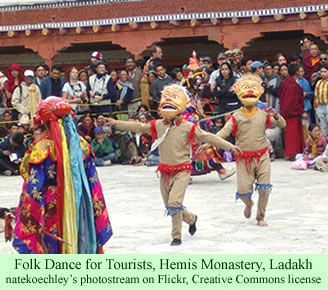According to a news story last week, the Jammu and Kashmir state Director of Tourism, Talat Parvaiz, reported that 137,400 tourists have visited Ladakh so far this year. He also said that 11.68 crore rupees ($US 1,900,000) has been spent on tourism development projects in the Ladakh region during the same period. The report did not indicate how much money the tourists brought to Ladakh.
 According to another official, Minister of Tourism Gulam Ahmed Mir, “all efforts are being made to promote the tourism industry and attract tourists from across the globe to the State.” Mr. Mir emphasized the importance of bringing in tourists—and the need for expanding programs that will foster cultural heritage tourism.
According to another official, Minister of Tourism Gulam Ahmed Mir, “all efforts are being made to promote the tourism industry and attract tourists from across the globe to the State.” Mr. Mir emphasized the importance of bringing in tourists—and the need for expanding programs that will foster cultural heritage tourism.
So far, it appears as if the tourists only have a negative effect on the Ladakhi on sporadic occasions. In fact, one visiting scholar felt that the Ladakhis enjoy being photographed by tourists. They see tourism as an appropriate way to bring in needed outside revenue, and will dress in their colorful traditional costumes in order to be photographed by the visitors at the numerous summer festivals.
However, some Ladakhi leaders did take strong exception to the sex, alcohol, and drugs that pervaded a music festival in the summer of 2009. Conservative Buddhist leaders were able to convince the state government to cancel the festival at the last moment in 2010. Other observers also recognize the danger that tourism can pose to traditional Ladakhi culture and values, and have been advocating appropriate measures to control the growth of the industry.
While the news report last week does not provide any further analysis of the situation, the presentation of statistics helps outsiders—and, more critically, the Ladakhis themselves—to understand the extent of their tourist business.
Although tourists visit some of the other peaceful societies, the Amish are by far the largest magnet for visitors. According to a Lancaster County promotion website, about 10 million tourists come to the county every year, generating an economic impact of $1.8 billion. Much of the tourism business is based, directly or indirectly, on the presence of 31,000 Amish in the county, some of whom do, of course, benefit directly from the tourist trade.
Numerous writers have discussed the resentments that many Amish in the county feel about the inaccuracies of films and TV shows, and they are offended by tourists who take their pictures without permission. But when and if the Ladakhi have nearly 100 times as many tourists as they do now—numbers comparable to those of Lancaster County—they might find their welcoming attitudes wearing thin also.